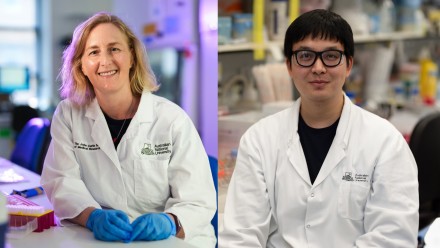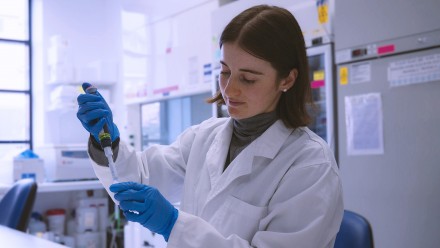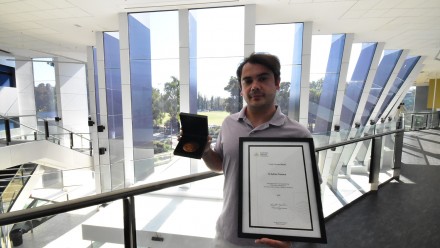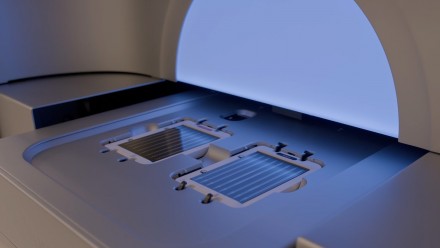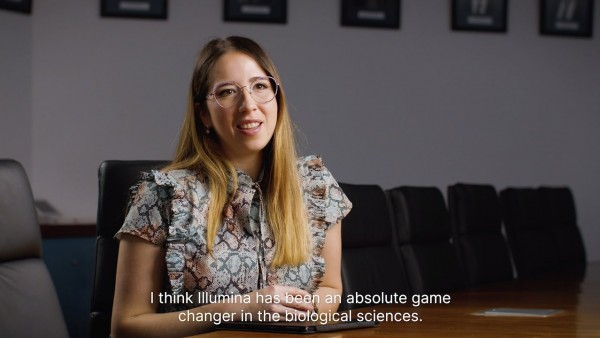Illumina Sequencing
Illumina Next Generation Sequencing (NGS) is a massively parallel DNA sequencing technique, using sequencing-by-synthesis chemistry to sequence millions or billions of DNA fragments simultaneously. The basic procedure involves:
- Library preparation: DNA or RNA-derived cDNA is fragmented into smaller pieces and special Illumina adapters are added to the blunt ends of the fragments. During this step, unique DNA barcodes carried by the Illumina adapters are incorporated into the fragments in a sample, allowing multiple libraries to be multiplexed into a single sequencing run and distinguished during data analysis.
- Clustering: the pool of libraries are delivered to a flow cell - a glass slide with hollow channels that capture and fix the library fragments to the surface through the Illumina adapters. Library fragments undergo clonal amplification to produce clusters, where each fragment in a cluster is identical as they originate from an original template fragment.
- Sequencing: nucleotides carrying a fluorophore and reversible terminator are delivered to the flow cell and incorporated into the clusters by a polymerase. The terminators inhibit extension, enabling fluorophore excitation and imaging, one nucleotide at a time. The terminators are removed, the next nucleotide is incorporated, and so on. Imaging intensities are extracted and bases are called and converted into raw basecall files.
- Analysis: sequencing data is demultiplexed according to the library barcodes added during library preparation and converted into FASTQ files, which can then be used as input for bioinformatic analysis.
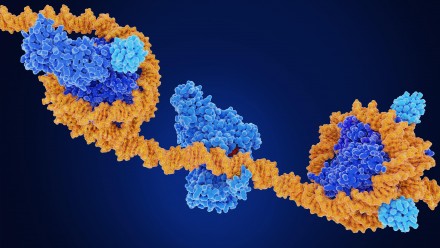
ATAC-seq »
ATAC-seq is a molecular biology technique used to analyse chromatin accessibility on a genome-wide scale, providing insight into regions accessible for transcription factors and regulatory proteins, active regulatory elements like promoters, enhancers, and regions of active transcription.
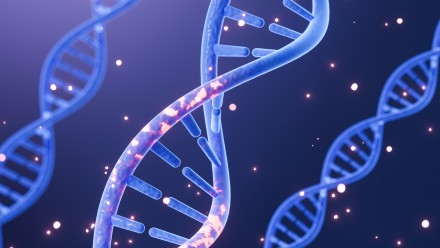
DNA-seq »
We offer various sequencing solutions for your DNA-seq project, including sequencing libraries prepared by you, library preparation by us from samples you have submitted, and modifying existing protocols with flexible criteria for submitting unconventional or difficult sample types.

HiC: 3D Genome Organisation »
HiC is a powerful molecular technique that allows scientists to study the three-dimensional organization of the genome by capturing interactions between distant DNA segments. With HiC, researchers can gain insights into the spatial arrangement of chromosomes and how it influences gene regulation and genome function.
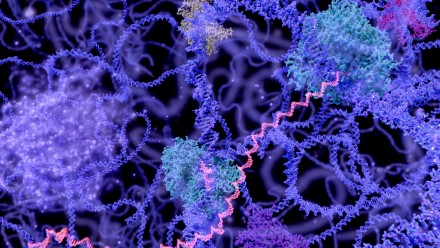
Methyl-seq »
Uncover the DNA methylation status of your samples with methyl-seq: a cutting-edge epigenetic profiling technique that resolves DNA methylation status through sequencing, providing valuable insights into their functional implications in various biological processes.
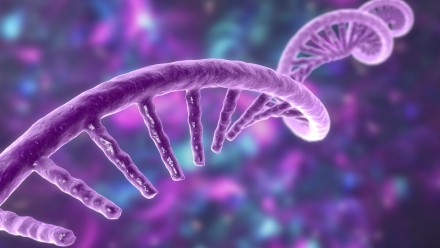
RNA-seq »
We provide RNA-seq library preparation for a wide range of sample types and project goals, including strand-specific mRNA prep for transcriptome sequencing or total RNA with ribo-depletion for the preservation of non-coding RNA, as well as low input, degraded and small RNA library prep.

Single Cell RNA-seq »
Substitute bulk RNA-seq with single-cell sequencing for the resolution of cell populations, differential transcriptomics, V(D)J immune profiling and fixed RNA profiling. We use 10x Genomics Chromium iX for cell barcoding and construction of various library types, sequenced on Illumina platforms.
How it works
Illumina sequencing outputs are reported in units of megabases (Mb), gigabases (Gb) and terabases (Tb), as well as the total number of reads generated in millions or billions. Sequencing runs on Illumina instruments can take the form of single-end reads, meaning all reads are performed on the forward strand of the DNA templates - this is called Read 1. They can also take the form of paired-end reads, where the complementary strand is resynthesised after Read 1 and the forward template strand is washed away, and then reads are performed on the complementary strand in the opposite direction - this is called Read 2.
A single-end sequencing run, with read lengths of 100 bp for example, is denoted as 1 × 100 bp, and a paired-end run is denoted 2 × 100 bp. If you wish to sequence with 100 bp single-end reads, then we will use a 2 × 50 bp sequencing kit and set up the run using all 100 cycles for Read 1. Some Illumina instruments can produce paired-end reads up to 300 bp (2 × 300 bp). However, not all flow cells are compatible with all read lengths, for example, a MiSeq v2 flow cell supports read lengths up to 250 bp, but not 300 bp. The tables below detail flow cell outputs with their associated read lengths for each sequencer.
Illumina MiSeq
The MiSeq is a versatile and cost-effective benchtop sequencer, supporting targeted resequencing and small-genome sequencing, as well as library QC for larger sequencing projects.
| v2 Nano | 1 million reads | ||
|---|---|---|
| Read length | 2 × 150 bp | 2 × 250 bp |
| Output | 300 Mb | 500 Mb |
| v2 Micro | 4 million reads | |
|---|---|
| Read length | 2 × 150 bp |
| Output | 1.2 Gb |
| v2 | 15 million reads | ||||
|---|---|---|---|---|
| Read length | 1 × 36 bp | 2 × 25 bp | 2 × 150 bp | 2 × 250 bp |
| Output | 540-610 Mb | 750-850 Mb | 4.5-5.1 Gb | 7.5-8.5 Gb |
| v3 | 25 million reads | ||
|---|---|---|
| Read length | 2 × 75 bg | 2 × 300 bp |
| Output | 3.3-3.8 Gb | 13.2-15 Gb |
Illumina NextSeq 2000
The NextSeq 2000 is a flexible and efficient benchtop sequencer that utilises super-resolution optics and enhanced patterned flow cell technology to maximise the output of the sequencing run.
| P1 | 100 million reads | |||
|---|---|---|---|
| Read length | 2 × 50 bp | 2 × 150 bp | 2 × 300 bp |
| Output | 10 Gb | 30 Gb | 60 Gb |
| P2 | 400 million reads | |||
|---|---|---|---|
| Read length | 2 × 50 bp | 2 × 150 bp | 2 × 300 bp |
| Output | 40 Gb | 120 Gb | 180 Gb (300 million reads) |
| P3 | 1.2 billion reads | ||||
|---|---|---|---|---|
| Read length | 1 × 50 bp | 2 × 50 bp | 2 × 100 bp | 2 × 150 bp |
| Output | 60 Gb | 120 Gb | 240 Gb | 360 Gb |
Illumina NovaSeq 6000
The NovaSeq 6000 is a powerful high-throughput sequencer, offering scalability and flexible output options to suit your research goals. Dual flow cell compatibility enables simultaneous sequencing runs and flow cell design allows segregation of libraries into separate lanes.
| SP | 800 million reads | ||||
|---|---|---|---|---|
| Read length | 2 × 50 bp | 2 × 100 bp | 2 × 150 bp | 2 × 250bp |
| Output | 65-80 Gb | 134-167 Gb | 200-250 Gb | 324-400 Gb |
| S1 | 1.6 billion reads | |||
|---|---|---|---|
| Read length | 2 × 50 bp | 2 × 100 bp | 2 × 150 bp |
| Output | 134-167 Gb | 266-333 Gb | 400-500 Gb |
| S2 | 4.1 billion reads | |||
|---|---|---|---|
| Read length | 2 × 50 bp | 2 × 100 bp | 2 × 150 bp |
| Output | 333-417 Gb | 667-833 Gb | 1000-1250 Gb |
| S4 | 10 billion reads | |||
|---|---|---|---|
| Read length | 1 × 35 bp | 2 × 100 bp | 2 × 150 bp |
| Output | 280-350 Gb | 1600-2000 Gb | 2400-3000 Gb |
NovaSeq X Plus
The NovaSeq X Plus is Illumina's latest technological innovation, combining dual flow cell configuration with the most advanced and efficient XLEAP-SBS chemistry to generate massive quantities of data with unprecedented quality.
| 1.5B | 1.6 billion reads | |||
|---|---|---|---|
| Read length | 2 × 50 bp | 2 × 100 bp | 2 × 150 bp |
| Output | 165 Gb | 333 Gb | 500 Gb |
| 10B | 10 billion reads | |||
|---|---|---|---|
| Read length | 2 × 50 bp | 2 × 100 bp | 2 × 150 bp |
| Output | 1 Tb | 2 Tb | 3 Tb |
| 25 B | 26 billion reads | |
|---|---|
| Read length | 2 × 150 bp |
| Output | 8 Tb |
After discussing your required sequencing depth with the BRF, download and complete the order form for the chosen sequencer. If we are sequencing a library prepared by you, download the "Sequencing-Ready Libraries" version of the form. If we are preparing libraries from your samples and sequencing them, download the "BRF-Made Libraries" version of the form.
Files
- MiSeq Order Form (BRF-Made Libraries).docx (DOCX, 2.78 MB)
- MiSeq Order Form (Sequencing-Ready Libraries).docx (DOCX, 2.78 MB)
- NextSeq 2000 Order Form (BRF-Made Libraries).docx (DOCX, 2.78 MB)
- NextSeq 2000 Order Form (Sequencing-Ready Libraries).docx (DOCX, 2.78 MB)
- NovaSeq 6000 Order Form (BRF-Made Libraries).docx (DOCX, 2.78 MB)
- NovaSeq 6000 Order Form (Sequencing-Ready Libraries).docx (DOCX, 2.78 MB)
- NovaSeq X Plus Order Form (BRF-Made Libraries).docx (DOCX, 2.78 MB)
- NovaSeq X Plus Order Form (Sequencing-Ready Libraries).docx (DOCX, 2.78 MB)
General
- The BRF operates on a cost recovery basis, and the percentage of subsidization is determined by The John Curtin School of Medical Research.
- No samples or orders will be processed without a sample submission/order form and valid charge code, authorised by the signature of the PI/Lab Head, or by granting of electronic access to BRF ordering systems with the authority of the PI/Lab Head.
- It is a condition of the contract between the ACRF and JCSMR/ANU that "the Foundation (ACRF) is to be acknowledged in all scientific publications which utilise the Facility (BRF) at the Institute (JCSMR)". All work performed in the BRF, whether full service or not, and the use of any BRF resources should be acknowledged in all publications arising from that work. This should be in the “Material and Methods” section of the paper (see examples below). Any further individual acknowledgements are solely at your discretion.
- A reference to the publication should be sent to the Manager of the BRF once the paper is published (includes theses).
- BRF collaborations and co-authorship: although the BRF is primarily a service unit, there are instances where BRF staff make significant contributions to either the technical or intellectual input of the project. This should be discussed with the staff member concerned prior to the commencement of the collaboration.
Consumables and data
- The customer agrees to cover the cost of any consumables ordered on their behalf if the customer fails to supply the correct quantity and quality of the starting material required for processing. Details of the quality and quantity required are on the BRF website and sample submission form.
- Customers are responsible for archiving data generated by the BRF. Data generated by the BRF are solely for the use of the customer and their collaborators. Data is not to be sold to a third party. The BRF shall not be responsible for data output generated from samples that deviate from recommended protocols as requested by the customer.
- Upon receipt of consumables and/or data, the customer accepts responsibility for the correct handling, use, storage and disposal of the consumables/data.
- The BRF extends no warranties of any kind in respect to the consumables. Any consumables sold may have hazardous properties. The customer agrees to use appropriate caution and safeguards as not all properties are known.
- Consumables sold by the BRF shall not be transferred to another party without the written consent of the BRF. The BRF is not responsible for any losses arising from the use of consumables. The BRF will not be liable to the customer for any loss, claim or demand made by the customer due to acceptance, handling, use, storage or disposal of consumables and/or data by the customer, except to the extent permitted by law when it is the result of willful misconduct on the part of the BRF or its employees.
Acknowledgement in Publications
Examples
Real-time PCR
“Amplifications were performed in 384-well optical reaction plates (Applied Biosystems) with a 7900HT Fast Real-Time PCR System at the Genome Discovery Unit - ACRF Biomolecular Resource Facility, The John Curtin School of Medical Research, Australian National University using SDS 2.4 software to analyse raw data.”
DNA Sanger Sequencing
Amplified PCR products were purified and sequenced on an AB 3730xl DNA Analyzer (at the Genome Discovery Unit - ACRF Biomolecular Resource Facility, The John Curtin School of Medical Research, Australian National University) following the manufacturer's protocol (Applied Biosystems 2002).”





